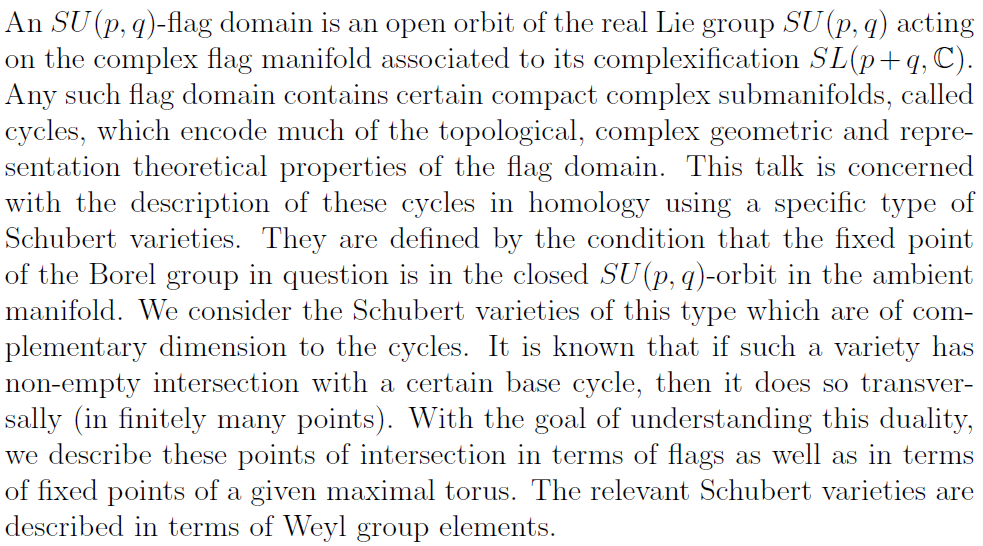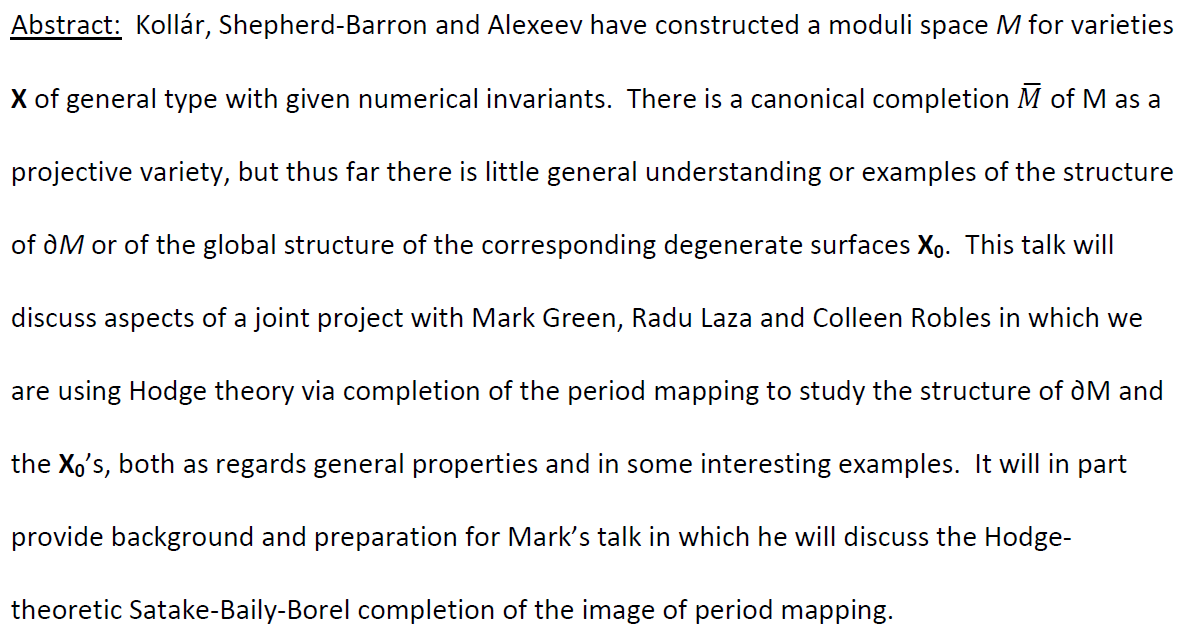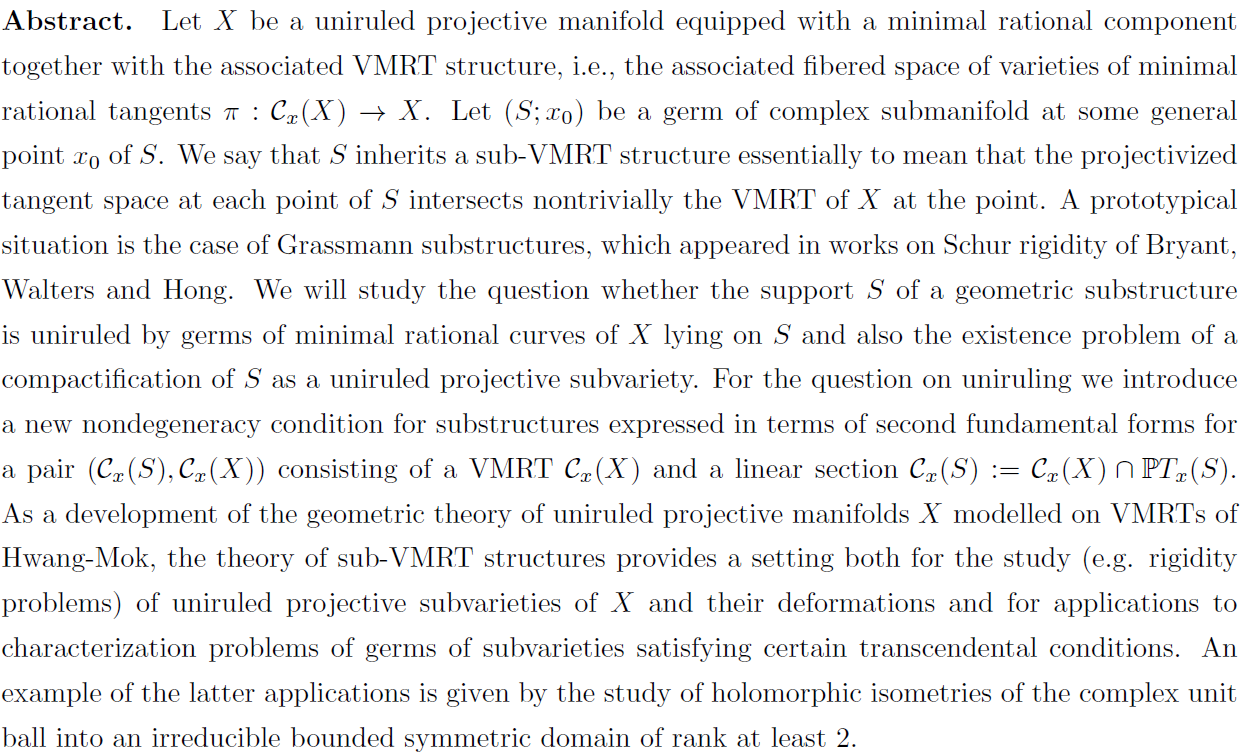Workshop on Flag Domains and Cycle Spaces
Date: May 22 - 26, 2017 Place: 5th Floor, 1503, KIAS |

| Title & Abstract | Home > Title & Abstract |
Speaker: Ana-Maria Brecan (Bayreuth University)
Title: On the intersection pairing between cycles in  domains and maximally real Schubert varieties
domains and maximally real Schubert varieties
Abstract:

Speaker: Mark Green (University of California, LA)
Title: Three Constructions Associated to a Nilpotent Orbit
Abstract: This talk, a follow-up to the one by Phillip Griffiths, will survey some recent joint work with P. Griffiths, R. Laza and C. Robles. One of the overall themes of our work has been multi-parameter families of varieties and how the variation of their Hodge structures reflects their geometry, in particular, the relationship between the singularities the varieties acquire and the degeneration of their Hodge structures. Associated to such a multiparameter family is a nilpotent orbit over a product of punctured discs. Some interesting algebraic invariants of such nilpotent orbits we have been studying are a semisimple Lie algebra, a monomial map that fills in across the punctures, and a metric on the determinants of the Hodge filtration bundles det(F^p).
Speaker: Phillip Griffiths (Institute for Advanced Study)
Title: Hodge Theory and Moduli

Speaker: Jun-Muk Hwang (Korea Institute for Advanced Study)
Title: Recognizing symplectic Grassmannians by their varieties of minimal rational tangents
Abstract: In a joint-work with Qifeng Li, we show that if the variety of minimal rational tangents (VMRT) of a uniruled projective manifold at a general point is projectively equivalent to that of a symplectic or an odd-symplectic Grassmannian, the germ of a general minimal rational curve is biholomorphic to the germ of a general line in a presymplectic Grassmannian. As an application, we characterize symplectic and odd-symplectic Grassmannians, among Fano manifolds of Picard number 1, by their VMRT at a general point and prove their rigidity under global Kaehler deformation. Analogous results for G/P associated with a long root were obtained by Mok and Hong-Hwang a decade ago by using Tanaka theory for parabolic geometries. When G/P is associated with a short root, for which symplectic Grassmannians are most prominent examples, the associated local differential geometric structure is no longer a parabolic geometry and standard machinery of Tanaka theory cannot be applied because of several degenerate features. To overcome the difficulty, we show that Tanaka's method can be generalized to a setting much broader than parabolic geometries, by assuming a pseudo-concavity condition that certain vector bundles arising from Spencer complexes have no nonzero sections. The pseudo-concavity condition is checked by exploiting geometry of minimal rational curves.
Speaker: Matt Kerr (Washington University, St. Louis)
Title: Admissible nilpotent cones
Abstract: Nilpotent cones in reductive Lie algebras are the basic linear-algebraic gadget underlying Hodge-theoretic compactifications of moduli spaces. They reflect the possible monodromies of multiparameter degenerations of varieties (over a product of punctured disks) and their attached variations of Hodge structure. In this talk, we describe results with C. Robles and G. Pearlstein which provide a combinatorial algorithm for classifying nilpotent cones up to a suitable equivalency, and relate this to geometry in a couple of examples.
Speaker: Bruno Klingler (University of Paris-Diderot)
Title: Bi-algebraic geometry and Hodge theory
Abstract: In this talk I will try to describe the relation between the Hodge locus of a variation of Hodge structure on a smooth quasi-projective complex variety, and the functional transcendence properties of the associated period map.
Speaker: Bong H. Lian (Brandeis)
Title: The Riemann-Hilbert problem for period integrals--recent applications
Abstract: I will discuss two recent applications of the Riemann-Hilbert problem for periods of CY manifolds. One of them deals with the hyperplane conjecture for toric hypersurfaces that goes back to the mid 1990's. The second application provide descriptions for zeros of derivatives of generalized hypergeometric functions. The lecture is based on joint work with A. Huang, S.-T. Yau and M. Zhu.
Speaker: Ngaiming Mok (University of Hong Kong)
Title: Sub-VMRT structures on uniruled projective manifolds

Speaker: Sui-Chung Ng (East China Normal University)
Title: On cycle spaces of flag domains on Grassmannians and the rigidities of holomorphic mappings
Abstract: We are interested in one of the simplest kinds of flag domains, namely, the SU(p,q) orbits on complex Grassmannians. The maximal compact complex submanifolds inside such a flag domain are smaller Grassmannians and their corresponding cycle spaces are the so-called Type-I irreducible bounded symmetric domains. We will try to explain how to make use of these cycles and cycle spaces to obtain rigidities of holomorphic mappings between the flag domains.
Speaker: Gregory Pearlstein (Texas A&M)
Title: Differential geometry of the mixed Hodge metric
Abstract: We describe the basic properties of a natural hermitian metric carried by classifying spaces of graded polarzied mixed Hodge structures.
Speaker: Nicolas Perrin (University of Versailles)
Title: Quantum K-theory of cominuscule spaces
Abstract: (joint work with A. Buch, P.-E. Chaput and L. Mihalcea) I will explain geometric techniques for computing products in the quantum K-theoretic ring of cominuscule spaces and describe finiteness and positivity consequences. I will also give a Chevalley formula in the equivariant setting. This completely describes the ring structure.
Speaker: Curtis Porter (North Carolina State University)
Title: Non-degeneracy in CR Geometry
Abstract: Orbits of real forms in complex flag manifolds often have interesting CR structures. These homogeneous spaces are known in some cases to be the "flat models" of a certain CR structure in the same sense that Euclidean vector spaces are the flat models of Riemannian geometry. In characterizing CR manifolds $M$, a central role is played by the Levi form $L$, which measures the failure of the CR bundle to be integrable, so that when $L$ has a nontrivial kernel of constant rank, $M$ is foliated by complex manifolds. If the local transverse structure to this foliation still determines a CR manifold $N$, $M$ is called straightenable, and the Tanaka-Chern-Moser classification of CR hypersurfaces with nondegenerate Levi form can be applied to $N$. It remains to classify those $M$ for which $L$ is degenerate and no such straightening exists. This was accomplished in dimension 5 by Ebenfelt, Isaev-Zaitzev, Medori-Spiro, and Pocchiola. I will discuss their results as well as my work (joint with Igor Zelenko) modifying Tanaka's prolongation procedure to treat the equivalence problem in arbitrary dimension, paying particular attention to the flat models.
Speaker: Aeryeong Seo (Korea Institute for Advanced Study)
Title: A Kobayashi pseudo-distance for holomorphic bracket generating distributions
Abstract: In this talk, a generalization of Kobayashi pseudo-distance on complex manifolds with holomorphic bracket generating distributions will be presented. For a semisimple Lie group G, a G-homogeneous complex manifold M with an invariant holomorphic bracket generating distribution is Kobayashi hyperbolic if and only if
the universal covering of M is a canonical flag domain with the superhorizontal distribution.
Speaker: Joseph A. Wolf (University of California, Berkeley)
Title: Infinite Dimensional Cycle Spaces
Abstract: We recall some main points of the theory of cycle spaces of (finite dimensional) flag domains, and indicate how the structure of those domains and cycle spaces extends (in some cases) to the infinite dimensional setting. The main tool for those cases is the interplay with a theory of infinite dimensional bounded symmetric domains.
